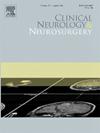The PANDA score: External validation and modification of a simple upfront prediction tool for poor outcomes despite successful stroke thrombectomy
IF 1.8
4区 医学
Q3 CLINICAL NEUROLOGY
引用次数: 0
Abstract
Background
While endovascular thrombectomy (EVT) has become standard of care for patients’ acute ischemic stroke (AIS) due to large vessel occlusion (LVO), many patients still suffer profound neurological disability, also termed futile recanalization (FR). The BAND score, which incorporates baseline disability, age, stroke severity, and treatment time window, is derived as a simple tool for upfront prediction of FR prior to EVT. This study aims to externally validate the BAND score and to incorporate upfront imaging biomarkers into the prediction tool.
Methods
Consecutive stroke thrombectomy patients with anterior circulation LVO who achieved successful recanalization (mTICI 2b or greater) were retrospectively identified at a single institution from 2019 to 2023. Clinical information, procedural details, and 90-day outcomes were recorded. The performance of the BAND score in predicting FR (90-day modified Rankin scale [mRS] >3) and loss of complete independence (LCID, 90-day mRS>2) was assessed. Then, Alberta stroke programme early CT score (ASPECTS) was added to create the PANDA score (pre-stroke disability, age, NIH stroke scale, delay from last known normal, and ASPECTS). The performance of PANDA to predict FR was assessed and compared with the original BAND score and also the widely validated THRIVE score.
Results
296 patients were included; 36.5 % experienced FR. BAND had areas under the receiver-operating curve (AUCs) of 0.72 and 0.74 for predicting FR and LCID, respectively (both p < 0.001). The new PANDA score had AUCs of 0.76 and 0.78 for predicting FR and LCID, respectively (both p < 0.001), and it outperformed both BAND and THRIVE (all p < 0.05). Of the 30 patients (11.2 %) with high PANDA scores (≥7), 24 patients (80.0 %) suffered FR and 26 (86.7 %) suffered LCID.
Conclusion
This external validation study confirmed the adequate performance of BAND in predicting FR. The improved PANDA score performed better than the original BAND score and the widely validated THRIVE score.
PANDA评分:一种简单的预先预测工具的外部验证和修改,用于预测成功的脑卒中血栓切除术后的不良预后。
背景:虽然血管内血栓切除术(EVT)已成为大血管闭塞(LVO)引起的急性缺血性卒中(AIS)患者的标准治疗方法,但许多患者仍然遭受严重的神经功能障碍,也称为无效再通(FR)。BAND评分结合了基线残疾、年龄、卒中严重程度和治疗时间窗,是EVT前FR预先预测的简单工具。本研究旨在外部验证BAND评分,并将前期成像生物标志物纳入预测工具。方法:回顾性分析2019年至2023年在单一机构连续卒中取栓并成功再通(mTICI 2b或更高)的前循环LVO患者。记录临床信息、手术细节和90天的结果。评估BAND评分在预测FR(90天改良Rankin量表[mRS] >3)和完全独立性丧失(LCID, 90天mRS>2)方面的表现。然后,将阿尔伯塔中风项目早期CT评分(ASPECTS)添加到PANDA评分中(中风前残疾、年龄、NIH中风量表、与最后已知正常人的延迟和ASPECTS)。评估PANDA预测FR的性能,并与原始BAND评分和广泛验证的THRIVE评分进行比较。结果:共纳入296例患者;36.5 %发生FR。BAND预测FR和LCID的受试者操作曲线下面积(aus)分别为0.72和0.74 (p均为 )结论:该外部验证研究证实了BAND预测FR的充分性能。改进的PANDA评分优于原始BAND评分和广泛验证的THRIVE评分。
本文章由计算机程序翻译,如有差异,请以英文原文为准。
求助全文
约1分钟内获得全文
求助全文
来源期刊

Clinical Neurology and Neurosurgery
医学-临床神经学
CiteScore
3.70
自引率
5.30%
发文量
358
审稿时长
46 days
期刊介绍:
Clinical Neurology and Neurosurgery is devoted to publishing papers and reports on the clinical aspects of neurology and neurosurgery. It is an international forum for papers of high scientific standard that are of interest to Neurologists and Neurosurgeons world-wide.
 求助内容:
求助内容: 应助结果提醒方式:
应助结果提醒方式:


